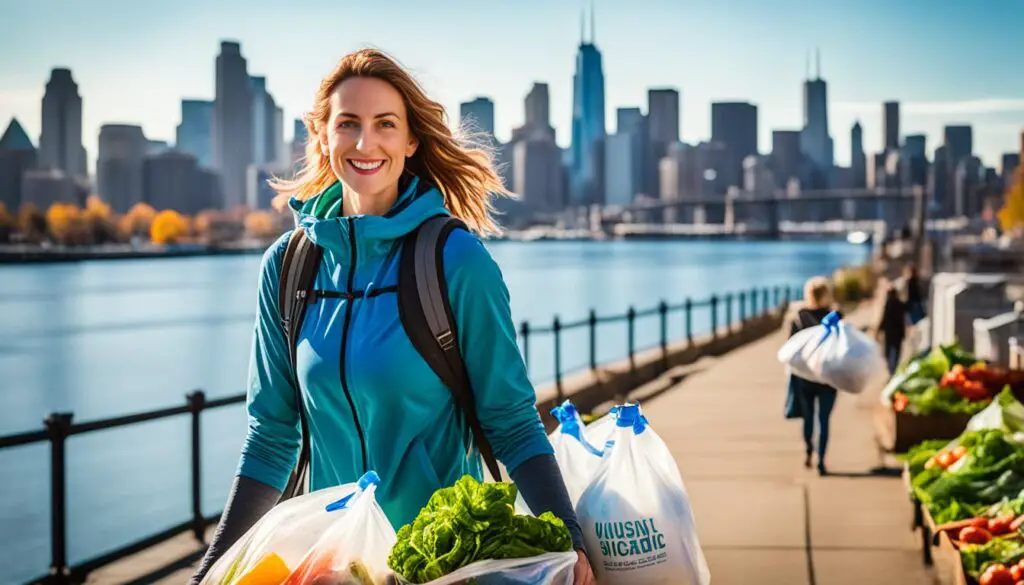Climate change challenges our food supply. As a mindful shopper, I see the importance of buying sustainably. It helps lessen our environmental impact and supports green practices.
Understanding the water footprint of our food is crucial for sustainable shopping. Foods have varying water needs. For instance, meat like beef, pork, and chicken need a lot of water. This is because of the water required for their feed and care. Dairy and some nuts also use a lot of water.
To shop more greenly, I choose foods with smaller water footprints. This supports eco-friendly practices from start to finish. Hence, I reduce my environmental mark and help the Earth.
Key Takeaways
- Sustainable grocery shopping helps reduce our carbon footprint and promotes eco-friendly practices.
- Understanding the water footprint of the food we consume can guide us in making sustainable choices.
- Foods like beef, pork, and poultry have high water footprints, while fruits and vegetables generally have lower footprints.
- Supporting locally sourced and seasonal produce reduces the environmental impact of long-distance transportation.
- By prioritizing foods with lower water footprints, we can actively participate in mitigating climate change.
The Impact of Grocery Choices on Carbon Footprint
Choosing sustainable food at the grocery store matters a lot. These choices affect your carbon footprint and the environment. We can pick foods that help the planet and cut down on carbon emissions.
Meat, especially beef and lamb, really adds to carbon emissions. This is due to the greenhouse gases from raising animals. If we eat less meat and try diets like pescatarian or vegan, we can lower our carbon footprint.
Eating more plants is good for the earth and us. Fruits and veggies have much smaller carbon footprints than meat. Adding more plant-based meals to our diet is a great way to reduce carbon emissions and eat well.
Choosing local and seasonal produce also reduces carbon emissions. When we buy food grown closer to home, it saves a lot of energy. This is because it cuts down on long transports and artificial growing conditions.
It’s also vital to support ethical and green businesses and brands. Look for products with eco-certifications that show they are friendly to the environment. By picking these products, we help promote a sustainable food system.
Our grocery choices are key in shaping our carbon footprint. By choosing plant-based options, eating less meat, and buying local, we help the planet. Together, we can support a greener future for all.
Practical Tips for Sustainable Grocery Shopping
To make your grocery trips eco-friendly, start with a simple step. First, prioritize locally sourced and seasonal produce. This move cuts down on emissions from transportation. It also means giving a boost to local farmers.
Using reusable bags and containers is key too. It helps you say no to single-use plastic bags that harm our planet. Always remember to carry them when you hit the stores.
Trying out plant-based or lower-impact protein alternatives can also lower your carbon trace. Foods like legumes, tofu, and tempeh are both tasty and eco-friendly. They’re great for the environment and exploring new flavors.
When buying, it’s smart to look for eco-certifications and labels. Certifications like USDA Organic or Fair Trade mean the products are grown responsibly. They match strict environmental and labor standards.
Also, favour items with minimal or recyclable packaging. Choose products in materials you can recycle or compost. This reduces packaging waste, making your shopping greener.
By following these steps, you’ll help cut down your carbon footprint. Small efforts by each of us can lead to a healthier planet. Together, we can make a big impact on our environment’s future.
| Practical Tips for Sustainable Grocery Shopping |
|---|
| Prioritize locally sourced and seasonal produce |
| Use reusable bags and containers |
| Explore plant-based or lower-impact protein alternatives |
| Pay attention to eco-certifications and labels |
| Favour items with minimal or recyclable packaging |
Conclusion
Shopping for food in a sustainable way is key to a better planet. When I choose wisely at the store, I help fight climate change. I also help cut pollution and save natural treasures.
By picking sustainable items, I support local workers and fair jobs. It’s a good move for our earth and our communities.
Sustainable shopping helps save different kinds of life on earth. It also reduces the harm we do to the planet with our food needs. Choosing this way, we all do our part in caring for the world.
My choices at the store can lead to a greener tomorrow. By picking products that care about the earth, I make a difference. It’s a choice we all can make for a better future.
We can change things for the better with what we buy. This choice can inspire others, too. By working together, we can achieve a healthier planet for everyone.



